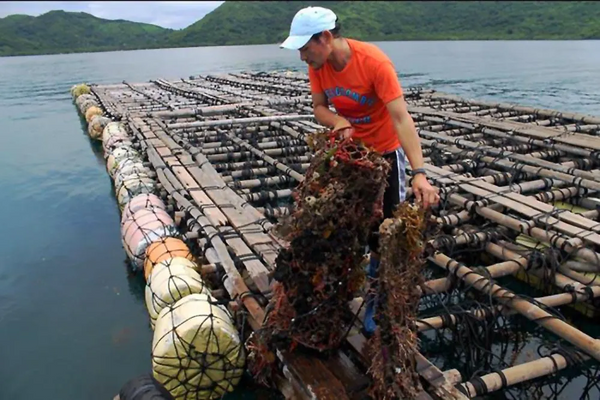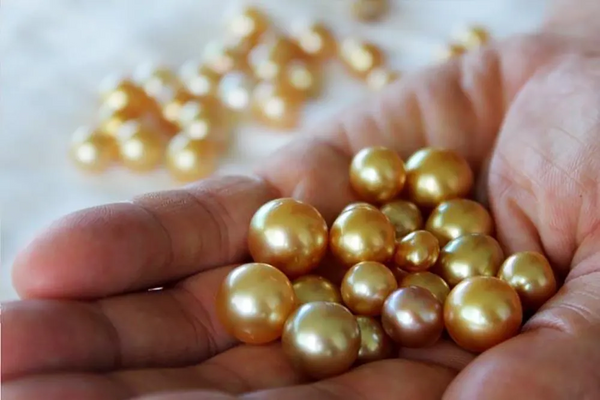
Often referred to as the Rolls Royce of pearls, South Sea pearls are the most prestigious of all pearl varieties. These stunning pearls also happen to be the largest and rarest, making them the most valuable. A string of South Sea pearls, whether white or gold, is instantly eye-catching and creates a statement look.
Buying South Sea pearls can be a little daunting due to their high price and scarcity. Let's take a look at how South Sea pearls differ from other varieties and if it's right for you.
What are South Sea Pearls?
South Sea pearls are the rarest type of all pearls. They are grown in brine and have a thicker nacre than any other pear, with an average thickness of about 2-4 mm. Like most saltwater oysters, they are pitted. They have a growth period of 2-4 years and are about twice as long as Japanese Akoya pearls. South Sea pearl oysters are highly susceptible to disease and stress, so their farming is limited to their native natural environment.
They range in color from white to gold and have a sheen that has been described as soft and luxurious. Their "smooth" appearance, as described by the jeweler, differs from Akoya pearls, which appear hard. They seem to radiate from within, rather than the mirror-like sheen expected from Akoya pearls. This is because of the large aragonite platelets they form.
Where Do South Sea Pearls Come From?
Wondering where pearls come from? We've got the answer...

Cultivating white and gold South Sea pearls requires a lot of time and expertise. Most white South Sea pearls are found in the waters off northwestern Australia, while most golden South Sea pearls are found in the Philippines and Indonesia.
In Australia, most pearls are collected in the wild, supplemented by hatch-cultured pearls to maintain a healthy supply. In other regions, however, the opposite is true, with hatch-cultured pearls in the majority. Government organizations in these countries closely monitor the sources to ensure they are well maintained to continue production.
The Australian city of Broome has been the commercial centre of the South Sea pearl industry since the 1850s. At the time, the city had a bad reputation but has now transformed into a beautiful and sophisticated city that reflects the high-tech nature of their industry.
South Sea Pearl Colors and Shades
South Sea pearls are known for their unique and stunning gold and white colors. White varieties come in silver, ivory, bright white and blue, and account for about 90 percent of the total South Sea pearl production. Blue South Sea pearls are very rare and can be intense in color. Golden pearls come in cream, champagne and deep gold and are very rare.

Unlike some other pearl varieties, the overtones of South Sea pearls are usually not very noticeable. Instead, it's the pearl's body color that's most noticeable. Because of the stunning natural color of these pearls, the color is rarely enhanced.
South Sea Pearl Shape
South Sea pearls come in a variety of organic shapes, and perfectly round spheres are very rare. This means that a string of perfectly matched South Sea pearls is difficult to put together and therefore very valuable. The main shapes of pearls are round, near-round, baroque, round and drop-shaped.

Round South Sea pearls are the most sought after, but also the rarest shape. Irregular shaped jewelry is now more popular as people opt for unique and personalized jewelry designs.
How Big are South Sea Pearls?
Because Pinctada maxima is the largest pearl producing oyster and can form pearls within a few years, South Sea pearls are known for growing to very large sizes. Most pearls range in size from 8.0mm to 20.0mm, but pearls over 15.0mm are very rare.
South Sea Pearl Luster
Luster refers to the lustre of a pearl and is one of the most important aspects to consider when shopping for pearl jewelry. Other things being equal, pearls with better luster are always more valuable.
When light is reflected and refracted from a pearl, we see it as luster. South Sea pearls tend to have a unique and highly reflective luster that is distinct from other pearl varieties.
South Sea Pearl Value
These are usually the most expensive of all pearls. They can be very expensive to buy, with an average size necklace costing $3,000 to $30,000 or more. Of course, value is influenced by pearl quality factors. For example, baroque shaped pearls or pearls with a lower luster are generally less expensive.
What is the Best Color for South Sea Pearls?
While white pearls have always been the classic choice, golden South Sea pearls are a rarer and more luxurious option for those who want to stand out. They range from soft champagne to intense gold. Golden pearls are said to bring wealth and prosperity to their owners.

Why are South Sea pearls so expensive? Only a small percentage of South Sea pearls are perfectly spherical, so a complete string of pearls is indeed a rare sight. Matching the color, size and overall quality of South Sea pearls is a time-consuming process. A string of pearls must be of the same quality level so as not to dwarf each other and be presented in the best possible light.
South Sea white pearls are rarer and larger than any other pearls, so they are much more expensive. The price of South Sea pearls depends on their quality, shape and size, with golden South Sea pearls running into the thousands of dollars and white pearls even higher. It is not uncommon for South Sea pearl necklaces to cost between $10,000 and $300,000. Baroque South Sea pearls are generally more affordable and are most often used alone in jewelry to showcase their unique shape.
How Can I Tell if My South Sea Pearls are Real?
The process is the same for all pearls. To tell if your pearls are real, you can use some simple methods.

The first test to try is the texture test. A real pearl will feel slightly rough when rubbed against another pearl or tooth. If it's completely smooth, then it's not a pearl.
Real pearls also have subtle imperfections, which can vary. Pearls that are perfectly spherical and identical in appearance are most likely not real.
Another good test is exposing the pearls to flames. Real pearls won't suffer any damage and don't give off odor, while fake pearls may melt or lose their color and smell weird.
In contrast, real pearls are also slightly heavier and should feel cold to the touch at first.
How to Care for South Sea Pearls
Pearls are very soft, with a Mohs hardness of only 2.5 to 4.5. Proper maintenance of pearls is essential to ensure that they remain lustrous and beautiful for decades to come. One of the easiest ways to keep them shiny is to wear them regularly. The body oils they come in contact with keep the pearls hydrated and polished.
Clean and maintain your pearls regularly to prevent dirt build-up. After each wearing of South Sea pearls, wipe them clean before storing them. When washing them, never submerge the pearls. Wipe off dirt with a soft cloth, then rinse with running water. Avoid hanging your pearls, as this will stretch the string and possibly cause it to break.
Have a professional jeweler check the integrity of your pearl chain once a year. Most pearl chains require rethreading every 2 to 3 years.
Avoid any harsh chemicals or ultrasonic cleaners as they can damage your pearls. When storing pearls, keep them in a ventilated environment with good ventilation and moisture, as this will prevent the pearls from drying out, becoming brittle, and discoloring. Pearls are very soft and must be stored separately to avoid being scratched by other objects.
Al so Read: What are Freshwater Pearls?



